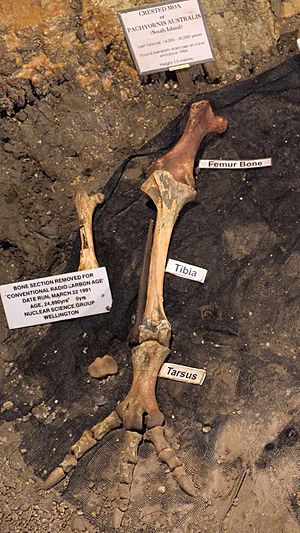Pachyornis australis facts for kids
Quick facts for kids Pachyornis australisTemporal range: Late Holocene
|
|
|---|---|
 |
|
| Pachyornis australis bones in Ngarua Caves | |
| Conservation status | |
| Scientific classification | |
| Genus: |
Pachyornis
|
| Species: |
australis
|
| Synonyms | |
|
List
Pachyornis elephantopus Cracraft 1976 non (Owen 1856) Lydekker 1891
Mesopteryx sp. β Parker 1895 |
|
The crested moa, Pachyornis australis, was a type of moa that once lived in New Zealand. Moa were large, flightless birds, similar to modern-day emus or ostriches. The crested moa was one of nine known moa species.
Moa belong to a group of birds called Palaeognathae. This group includes other well-known birds like kiwi, cassowaries, rheas, and tinamous. Many birds in this group cannot fly. They also lack a special bone called a keel on their sternum (breastbone), which is where flight muscles usually attach.
This moa was called "crested" because scientists found small pits in its skull. These pits suggest the bird might have had a crest of long feathers on its head. Similar pits have also been found on the skulls of other moa species, like Dinornis and Anomalopteryx.
Contents
What Did the Crested Moa Look Like?
The Pachyornis australis was a medium-sized moa, weighing around 75 kg (165 lb). This is about the same weight as a large adult human! It was smaller than its close relative, the heavy-footed moa (Pachyornis elephantopus). Sometimes, their bones were confused because they looked quite similar.
Not much is known about the feathers that might have formed the crest on its head. Scientists believe these feathers might have been used for showing off during courtship. They could also have been used to challenge other moa. Since no feathers have been found, we can only guess what color or size they might have been.
Where Did the Crested Moa Live?
The crested moa lived only on the South Island of New Zealand. It preferred to live in high-up, cool sub-alpine forests. These forests were mostly found in the North West part of the island, especially near the Nelson area.
Scientists have found crested moa remains in places like the Honeycomb Hill Cave and other nearby caves. This moa played a similar role in its environment to the heavy-footed moa. However, the heavy-footed moa usually lived in warmer, drier areas at lower altitudes. It's likely that the crested moa moved down to these warmer areas during the cold winter months.
What Did the Crested Moa Eat?
Like all moa species, the crested moa was a large plant-eater, or herbivore. In New Zealand, there were no native land mammals (except for bats). This meant the moa filled an important role in the ecosystem, eating plants and helping to shape the landscape.
The only major threat to the crested moa was the huge Haast's eagle (Harpagornis moorei). This giant eagle was a powerful predator that hunted large birds like the moa.
Why Did the Crested Moa Disappear?
For a long time, people thought the crested moa died out about 10,000 years ago. This was during a time of big climate changes. However, in 2012, new tests changed this idea. Scientists used radiocarbon dating on crested moa bones found in Bulmer Cavern. This test showed that the moa died between 1396 and 1442 AD. This was over 100 years after the first humans arrived on the South Island.
Even though the climate changed a lot before humans arrived, the crested moa adapted. They moved with their sub-alpine habitats as the elevation changed. Their numbers stayed fairly steady. The crested moa was one of the last moa species to disappear.
Unlike other moa species, there is no proof that humans hunted the crested moa. It seems their homes were too isolated and far away for people to reach easily. Instead, scientists believe the crested moa likely died out because of introduced mammals. These were animals brought to New Zealand by humans, such as rats, which would have eaten moa eggs and chicks.

